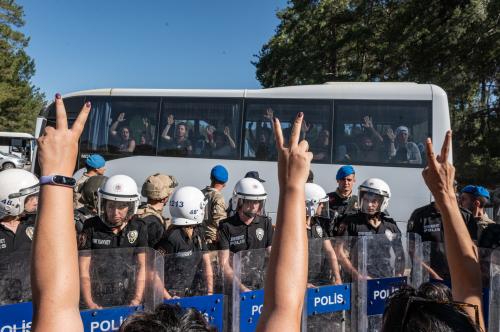The recent announcement that Mexican academic and former pollster Miguel Basáñez has been nominated as Mexico’s new ambassador to Washington provides us with a good excuse to revisit recent debates in Mexico regarding the bilateral relationship. More specifically, it’s a good time to debunk two urban myths, invoked in some Mexican academic and punditry circles. One is that the relationship during President Felipe Calderón’s term (2006 to 2012) was “narcotized,” meaning it had become heavily slanted toward counternarcotics cooperation. The other is that nothing was done to promote immigration reform in the United States.
Both of these arguments are utterly groundless, in large part because the bilateral relationship is too multifaceted to reduce it to only one issue. Even if one of the two nations were determined to boil it down to one single issue, the day-to-day of the agenda is so broad and deep that it would be impossible to turn it into a monothematic interaction.
Beyond drugs and thugs
It is true that cooperation in the fight against transnational criminal organizations was a significant component of Mexico’s agenda with the United States under Calderón. The emphasis on that issue was shaped by the country’s circumstances and the Mexican government’s agenda during that administration. However, it was also predicated on the need to foster a paradigm of shared responsibility—a first in the relationship—in order to address crime on both sides of the border and operating in both directions (drugs flowing northward, weapons and bulk cash flowing southward). Notwithstanding, just because a high priority was attached to that issue does not mean that the bilateral agenda was hamstrung by it. Similarly, just because public security was the central issue in the Mexican national debate doesn’t mean that it’s not also a strategic dimension in the Mexico-United States relationship.
With a shared land border of almost 2,000 miles, 35 million Mexicans and Mexican Americans living in the United States, and $1.4 billion dollars per day in two-way trade, no bilateral relationship in the world has the span and complexity of that between Mexico and the United States. There is no way for it to be a single-issue agenda. If that were the case, it would have been virtually impossible to make any progress on other areas, and progress was indeed made during the previous administration.
To cite only a few examples, critical progress was achieved in the resolution of longstanding trade disputes, such as over trucking as well as tuna and country of origin labeling (and new disputes that erupted over products like tomatoes and shrimp). Similarly, if drug enforcement cooperation had sucked up all the bandwidth of the U.S.-Mexico agenda, we would never made such a breakthrough in one of the most historic disputes of our relations: the All-American Canal. In so doing, we established the groundwork for a landmark agreement on the Colorado River (Minute 319), today regarded worldwide as a benchmark in solving international water disputes. Nor would we have reached a key agreement on the topic of trans-boundary reservoirs of oil in the Gulf of Mexico (the so-called Western Gap); the agreement provides certainty for future public auctions and joint exploitation of deep-sea water oil fields in that zone. And we would not have been able to negotiate, as we did, Mexico’s entry into the Trans-Pacific Partnership; inaugurate four new Ports-of-Entry along our border; constructively engage with the leading national Latino organizations in the United States for the first time; negotiate Mexico’s participation in Global Entry, a secure passenger program; or implement an aggressive and highly successful agenda of cultural and cultural industry promotion across the United States. In fact, we were so successful in these areas that the current Mexican administration has taken up the baton and continued to make good progress on several of the issues that the prior administration started to tackle.
Working behind-the-scenes
The argument that all efforts by the Mexican government to push for immigration reform were abandoned under Calderón is similarly unsubstantiated. Whether out of ignorance or in bad faith, some pundits have confused discretion and working under the radar—which, given the current political context in the United States, was and should be the Mexican approach—with inaction.
Nothing could be further from the truth. The major U.S. actors pushing for immigration reform can themselves attest that Mexico worked boldly and smartly to forge closer ties with members of Congress and civil society organizations lobbying for reform. The government also found novel ways to advocate for immigration reform at the state and local level by building partnerships and—as part of a new strategy—litigating through the submission of amicus briefs filed in response to the mushrooming of anti-immigration bills that popped-up in several state capitals. If a U.S. ambassador or consul in Mexico had done or said one-fourth of that, there would have been outcry across Mexico, with chest thumping and calls from the entire Mexican political spectrum for the immediate expulsion of those U.S. diplomats from Mexico!
Miguel Basáñez—the recently nominated ambassador of Mexico to the United States—will head to Senate confirmation soon. As he does so, the unique and multifaceted bilateral agenda between Mexico and the Unites States should serve as a reminder that he will need to multitask—if you will, to chew gum, whistle, and talk at the same time. He will face the tricky but rewarding task of managing what is undoubtedly one of the most complex bilateral relationships between any two countries on Earth.
This piece was translated and adapted from an original opinion piece by Ambassador Sarukhan that first appeared in El Universal (Mexico City) on August 12, 2015.



Commentary
Chewing gum, whistling, and talking: Managing the complex U.S.-Mexico relationship
August 24, 2015